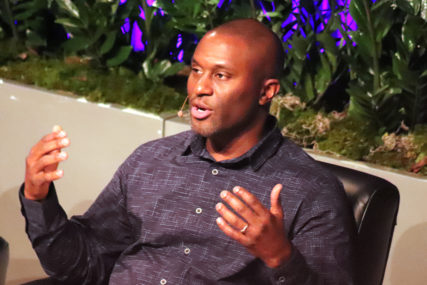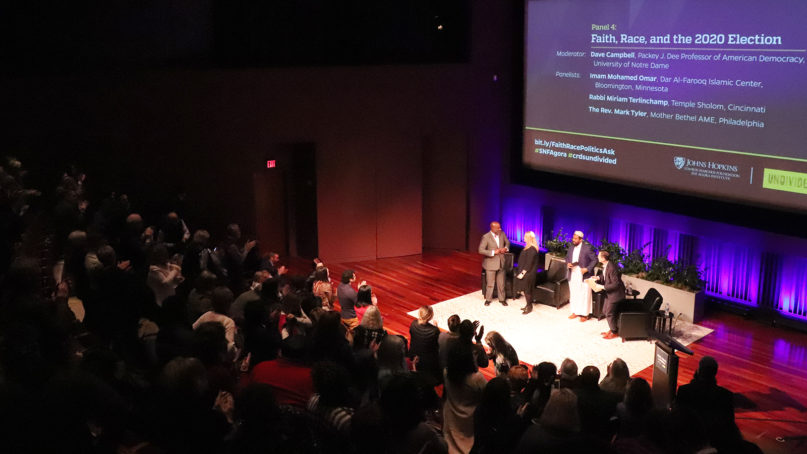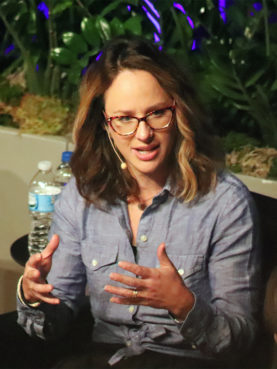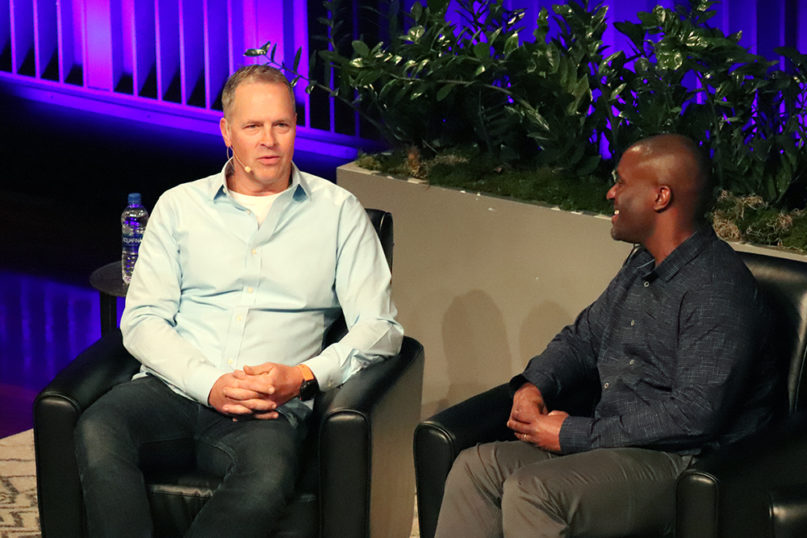The Rev. Martin Luther King Jr. described 11 o’clock on Sunday morning as the “most segregated hour in America.” This story is one in a series by Religion News Service about the future of segregation and integration in American religion, produced in partnership with Sacred Writes, a project that helps scholars share their research with a broader audience. The rest of the series can be found here.
CINCINNATI (RNS) — Many faith communities would consider it a success if they could once bring together people across racial and ethnic lines for worship.
But Crossroads, an 82% white, evangelical megachurch, has offered something more ambitious: six weeks of race-related discussions as part of an intensive effort to get people of different races and ethnicities to spend time together outside the worship hour.
“White people talking with white people about race is about as effective as black people talking to black people about race,” said Brian Tome, the white senior pastor of Crossroads Church, which has more than a dozen campuses in Ohio and Kentucky. “The problem is, how do white people and nonwhite people get together, how do we start to understand each other, how do we start to understand the story of one another?”

Chuck Mingo speaks during the Faith, Race and Politics conference on Jan. 13, 2020 at the National Underground Railroad Freedom Center in Cincinnati, Ohio. RNS photo by Adelle M. Banks
Those kinds of questions came to a head for Crossroads and its community in 2015, when Samuel DuBose, an unarmed black motorist, was fatally shot by a white University of Cincinnati police officer. Just a year before, Michael Brown’s killing by a white officer in Ferguson, Missouri, had begun a national conversation on police shootings of people of color.
“All of a sudden it was no longer academic,” said Chuck Mingo, the black pastor of Crossroads’ Oakley campus, who stood before his congregation in the wake of the shooting to call for ways to address the racial tension in the community and beyond it. “The church needs to be a part of the conversation.”
Since then, more than 5,000 people — and all of the church’s staff — have taken part in the six-week “Undivided” program, which brings people of different races to talk and eat together, learn about others’ previously undisclosed pain and become aware of their own unconscious biases. The groups have studied what the Bible says about how to treat one another and history “you probably did not learn in school,” said Lynn Watts, Crossroads spiritual growth site director.
RELATED: Multiracial churches growing, but challenging for clergy of color
Leaders of the “Undivided” program have developed “next steps” for participants — from mentoring inmates to tutoring inner-city children to working on a ballot initiative.
On Monday (Jan. 13), Crossroads Church was highlighted at a daylong conference at the National Underground Railroad Freedom Center, drawing some 200 people from the church and from across the country to review the church’s recent history and to consider how its example could be replicated.

Attendees applaud following a panel at the Faith, Race and Politics conference on Jan. 13, 2020 at the National Underground Railroad Freedom Center in Cincinnati, Ohio. RNS photo by Adelle M. Banks
Elizabeth Smyth, executive director of Johns Hopkins University’s Stavros Niarchos Foundation Agora Institute, the sponsor of the conference, said dialogues such as those started by the multicampus megachurch can lead to civic engagement that helps local communities.
“Institutions like Crossroads and citizens like those here in Cincinnati,” she said, “are discovering ways to engage in their communities where they talk and listen to one another and where they harness their collective power to create change for the better.”
A year after the program started, hundreds of Crossroads volunteers joined an interfaith coalition that knocked on doors and called voters via phone banks to help with the passage of Issue 44, a ballot initiative that provided $15 million for a preschool program that benefited low-income families in Cincinnati.
Troy Jackson, state strategies director for Faith in Action, a community organizing network, said it is rare for a congregation to mobilize the way Crossroads did on a political issue, an effort that included Mingo’s appearance in a television commercial asking for a tax increase.

Carolyn Heck speaks at the Faith, Race and Politics conference on Jan. 13, 2020 at the National Underground Railroad Freedom Center in Cincinnati, Ohio. RNS photo by Adelle M. Banks
“There are tax hikes for education that get voted down every year in this region,” said Jackson, who led the local faith-based AMOS Project that Crossroads joined in the effort. “This one won overwhelmingly.”
Carolyn Heck, a volunteer at Crossroads, said Mingo’s call to the congregation challenged her and “Undivided” prompted a personal transformation.
“I was part of the problem,” she told the audience on Monday that was mostly white but included people of a variety of races, ethnicities and faiths. “I was passive. I wasn’t making a stand. I wasn’t examining my own biases and so that process for me was full of grief.”
The white mother of three children, including an adopted African American son, co-founded the Undivided Justice Team and described collaborating on the preschool initiative as a “no-brainer.”
Now, she’s working on educating church members about the candidates in this year’s race for local prosecutor and partnering in the community to help defend young people accused of breaking the law.
“We know there’s just a lot of injustice in the juvenile system here,” she said in an interview. “How do we come alongside these children and their families and offer them the same support that children coming out of more affluent situations already have built into their experience?”






